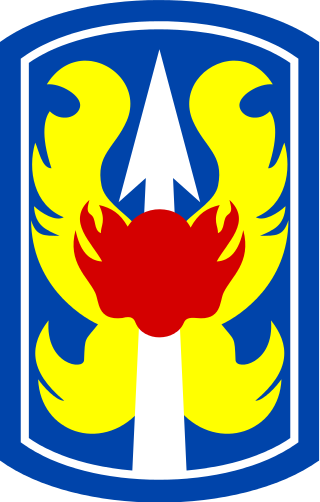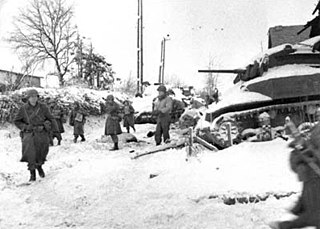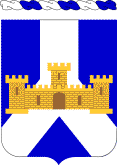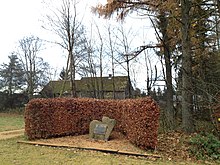
The 87th Infantry Division was a unit of the United States Army in World War I and World War II.

The 84th Training Command ("Railsplitters") is a formation of the United States Army. During World War I it was designated the 84th Division, American Expeditionary Forces; during World War II it was known as the 84th Infantry Division. From 1946 to 1952, the division was a part of the United States Army Reserve as the 84th Airborne Division. In 1959, the division was reorganized and redesignated once more as the 84th Division. The division was headquartered in Milwaukee in command of over 4,100 soldiers divided into eight brigades—including an ROTC brigade—spread throughout seven states.

The 80th Training Command is a formation of the United States Army Reserve.

The 79th Infantry Division was an infantry formation of the United States Army Reserve in World Wars I and II.

The 97th Infantry Division was a unit of the United States Army in World War I and World War II. Nicknamed the "Trident division" because of its shoulder patch, a vertical trident in white on a blue background, it was originally trained in amphibious assaults as preparation for deployment in the Pacific Theater. It was deployed to Europe in 1944 when casualties from the Battle of the Bulge needed to be replaced.

The 99th Infantry Division briefly existed, but never deployed, in the closing days of World War I, was reconstituted as a reserve unit in 1921, was ordered into active military service in 1942, and deployed overseas in 1944. The 99th landed at the French port of Le Havre and proceeded northeast to Belgium. During the heavy fighting in the Battle of the Bulge, the unit suffered many casualties, yet tenaciously held its defensive position. In March 1945, the 99th advanced into the Rhineland, crossing the Rhine River at Remagen on March 11. After fighting in the Ruhr area, the unit moved southward into Bavaria, where it was located at the end of the war.

The 85th Infantry Division also known as "Custer Division" was an infantry division of the United States Army in World War I and World War II. It currently exists as the 85th Support Command.

The Longest Winter: The Battle of the Bulge and the Epic Story of World War II's Most Decorated Platoon is a non-fiction book written by Alex Kershaw and published in 2004 by Da Capo Press. It became a New York Times bestseller.

The 199th Infantry Brigade (Light) is a unit of the United States Army which served in the Army Reserve from 1921 to 1940, in the active army from 1966 to 1970 (serving in the Vietnam War), briefly in 1991–1992 at Fort Lewis, and from 2007 as an active army training formation at Fort Moore.

Lyle Joseph Bouck, Jr. enlisted in the Missouri National Guard at age 14. During World War II, he was a 20-year-old lieutenant in charge of the Intelligence and Reconnaissance Platoon, 394th Infantry Regiment, 99th Infantry Division. On the first morning of the Germans' advance during the Battle of the Bulge, his 18-man unit along with four forward artillery observers held off an entire German battalion of more than 500 men for nearly an entire day, killing or wounding 92, and significantly delayed the German advance in a vital sector of the northern front. Every single member of the platoon was later decorated, making it one of the most decorated platoons in all of World War II. Bouck was one of the youngest commissioned officers in the U.S. Army.

The 158th Infantry Brigade is an infantry brigade of the United States Army. It has subordinate battalions throughout Florida and Puerto Rico.
The 5th Brigade, 78th Division was an AC/RC unit based at Joint Base McGuire–Dix–Lakehurst, New Jersey. The unit was responsible for training selected United States Army Reserve and National Guard units along the East coast. The brigade was a subordinate unit of First Army Division East, First United States Army when it was inactivated in 2006.

The 157th Infantry Brigade is an active/reserve component (AC/RC) unit based at Camp Atterbury, Indiana. The unit is responsible for training selected United States Army Reserve and National Guard units. The unit was activated using the assets of the 5th Brigade, 87th Division. The brigade is a subordinate unit of First Army Division East.
The 314th Infantry Regiment is an infantry regiment of the U.S. Army first organized in 1917.
The 304th Infantry Regiment currently consists of two battalions in the United States Army Reserve. In the current organizational plan of the U.S. Army, regimental designation is used only in historical tradition; there is no regimental commander, staff or headquarters. The 1st Battalion, 304th Regiment is headquartered in Londonderry, New Hampshire, and the 3rd Battalion, 304th Regiment is headquartered in Saco, Maine.

The Battle of Lanzerath Ridge was fought on December 16, 1944, the first day of the Battle of the Bulge during World War II, near the village of Lanzerath, Belgium, along the key route for the German advance on the northern shoulder of the operation. The American force consisted of two squads totalling 18 men belonging to a reconnaissance platoon and four forward artillery observers, against a German battalion of about 500 paratroopers. During a day-long confrontation, the American defenders inflicted dozens of casualties on the Germans and delayed by almost 20 hours the advance of the entire 1st SS Panzer Division, the spearhead of the German 6th Panzer Army.

The 395th Infantry Regiment was an infantry regiment of the United States Army, part of the 99th Infantry Division during World War II. It was organized with the rest of the 99th on 16 November 1942 at Camp Van Dorn, Mississippi. During the Battle of the Bulge, the regiment—at times virtually surrounded by Germans—was one of the few units that did not yield ground to the attacking Germans. On at least six occasions they called in artillery strikes on or directly in front of their own positions. Their success in defending Höfen resulted in the 395th Infantry being repeatedly assigned to other divisions for difficult assignments during the remainder of the war, earning them the sobriquet, Butler's Blue Battlin' Bastards. The unit was inactivated after World War II, then became a reserve unit, and was redesignated as the 395th Regiment in 1999.

The 197th Infantry Brigade is an active Infantry brigade of the United States Army. The brigade was active as an Organized Reserve unit from 1921 to 1942, in the Regular Army from 1962 to 1991, and as a TRADOC training unit from 2007 to 2013. The brigade saw service in Operation Desert Storm with the 24th Infantry Division. On July 31, 2020, the brigade was activated as a training brigade in Fort Moore, Georgia, to serve the increased training needs of the army.

The 393d Infantry Regiment is a U.S. Army Reserve regiment that is assigned to 75th Infantry Division.

The 107th Field Artillery Regiment is a Field Artillery Branch regiment of the United States Army. It has been affiliated with the Pennsylvania National Guard since its formation. It appears that the regiment last formally came into existence in June 1959, when the 107th Field Artillery Battalion was reorganized as the new Regiment's 1st Battalion in line with the Pentomic (ROCID) reorganization going on at that time.



















